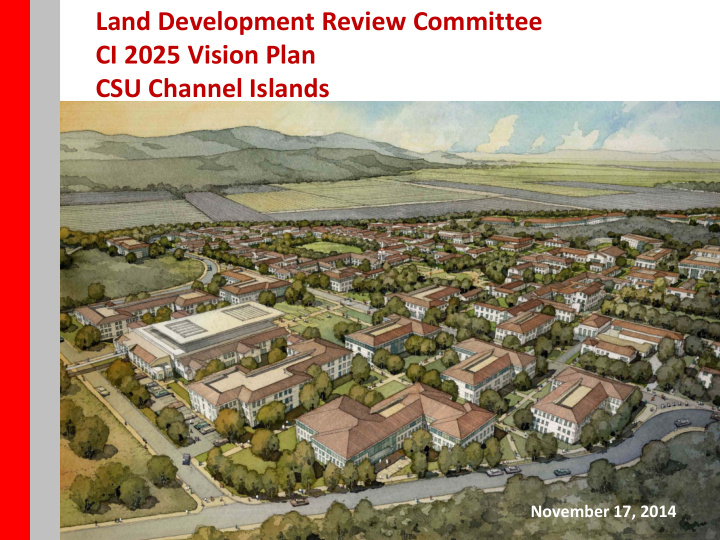



Land Development Review Committee CI 2025 Vision Plan CSU Channel Islands November 17, 2014
Agenda 1. Introductions 2. Campus History 3. Site Authority 4. CI 2025 Vision Plan 5. University Glen Development 6. Next Steps 7. Questions
Campus History
Campus History 1965 – Legislature calls for 4-yr university in Ventura (SB 288) • 1997 – State approves property transfer to the CSU (SB 623) • 1998 – Long Range Development Plan approved • 1998 – Site Authority established by Legislature (SB 1923) • 1999 – CSU Board approves establishment of CI as 23 rd campus • 2000 – Site Authority approves Campus Master Plan/Specific Reuse Plan • 2000 – CPEC approves establishment of CI • 2002 – CI opens with 500 transfer students •
Site Authority
Site Authority Overview The Site Authority was created to facilitate and provide for the financing and support of the transition of the site for use as a campus of the CSU. By mitigating the harmful effects and potential blighted conditions caused by the closure of the hospital, it was intended the SA would enhance the economic, cultural and social development of the region by facilitating the development of the campus and other compatible uses on the site. As such the SA was granted certain powers: Receives property and possessory interest tax • Receives sales and use tax generated on campus • Enter into contracts • Issue debt • Determine location and character of any project on the site • Lease projects • Invest/divest assets •
Site Authority History The Site Authority is responsible for the development and management of the east campus development area of CSU Channel Islands (commonly referred to as University Glen) including but not limited to rental apartments / townhomes, retail space, home sales, common area and oversight of the CI Power Plant. 1998 – Site Authority established by Legislature (SB 1923) • 2000 – Site Authority approves Specific Reuse Plan • 2002 – First residents of University Glen move in • 2006 – Phase IC begins to open • 2007 – Town Center begins to open • 2008 – Phase 2A/B construction suspended due to real estate market • 2013 – Begin planning for CI 2025 •
Planning Assumptions / Process Identify the optimal way to implement the CI 2025 programmatic needs • Evaluate alternative methods and opportunities to achieve delivery of • the programmatic requirements of CI 2025 - Assess existing financial situation - Evaluate all potential revenue sources and approaches to reducing costs - Evaluate alternative financing and development structures, including public/private and public/public partnerships - Develop multiple strategies to support the Program priorities Develop an implementation plan for the selected development strategy •
CI 2025 Vision Plan
Overview • Enrollment Growth - CI is a growing campus with increasing demand; full build out of 15,000 FTEs • Academic Need - Enrollment growth requires additional academic space for students & faculty to interact & engage in scholarly activity. • Student Housing Growth - Students want “college experience” that includes on-campus housing. CI can accommodate over 600 additional student beds • Residential Real Estate Market - Real estate market in Ventura County is improving. Phase 2A/2B development opportunity exists
Overview
Campus Land North Campus East Campus Campus Core Round Mountain Unbuildable East Land West Campus CoGen Plant Campus Core- 125 Acres West Campus- 22 Acres Peanut Hill North Campus- 153 Acres Total Developable Acreage- 300 Acres
Goals • Identify and leverage potential revenue sources - Site Authority (UG, housing, retail, tax increment) - Student housing, parking, retail, external events - Wellness/Recreation/Events Center - Public/public & public/private partnerships - Student fees - Grants, philanthropy, sponsorships, endowments • Decrease existing debt service for Site Authority • Develop viable economic plans to support CI’s growth - Academic, student life, residential - Plans for the next decade • Facilitate integration of campus with community
Projects Short Term (one – five years) Self Funded: - Dining Commons expansion - University Glen housing - Child Care Center - Student Housing expansion - Parking expansion - Student Health Center Partially Self Funded: - Wellness/Recreation Center Ph1 Non-Self Funded: : - Academic facilities
Projects Mid Term (six – ten years) Self Funded: - Retail expansion - Student Housing expansion - Parking expansion - Student Health Center expansion - Conference Center Partially Self Funded: - Wellness/Recreation/Events Center Ph2 Non-Self Funded: : - Academic facilities
Process/Schedule Dec. 2013 – SA Board approves plan to engage a development advisor • Dec. 2013 – RFP for Development Consulting Services issued • Engaged Jones Lang LaSalle as Development Advisor (June 2014) • Research & analyze financing options for projects • - Assess existing financial situation, academic needs, community partnership - Research market for revenue-generating projects Identify options to delivery projects that support campus growth • Review options for campus feedback/direction • Site Authority Board approved the concept in Sept. ’14 • Present to LDRC / CSU Board for approval in concept • Evaluate alternative methods and opportunities to achieve delivery of • the programmatic requirements of CI 2025
Process/Schedule • Identify optimal means to implement CI 2025 Vision Plan programmatic needs • Evaluate alternative methods & opportunities to achieve delivery of these programmatic needs - Assess existing financial situation - Evaluate all potential revenue sources & approaches to reducing costs - Evaluate alternative financing & development structures - Develop multiple strategies to support the Program priorities • Develop an implementation plan for the selected development strategy
University Glen Development
Next Steps
Next Steps • CSU Board of Trustee Approval of Concept - UG Phase 2A/2B development strategy - Continued interaction with Chancellor’s Office • CEQA Process - Identify strategy to complete this • Develop RFP
Questions
Recommend
More recommend